Monet's 'Water Lilies' and The Ripple Effect
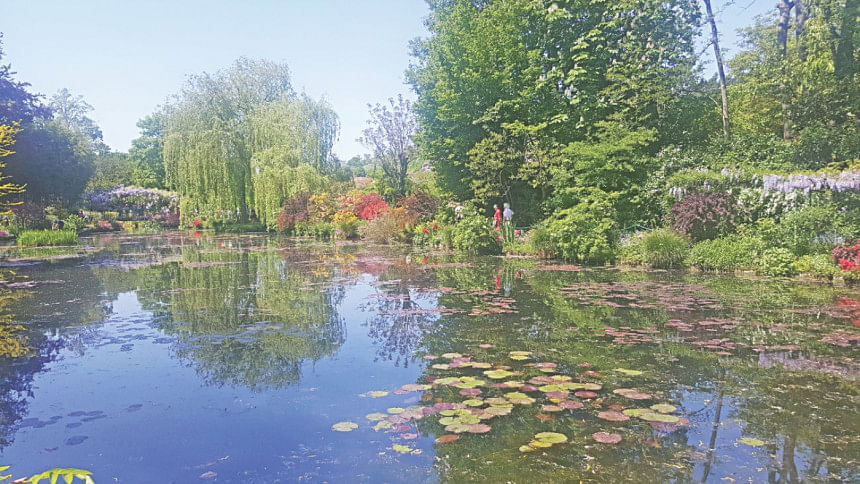
This past year spent studying in France has been a race against the clock. Weeks, months, and semesters passed, and my shortening stay in Paris saw the magnets on my refrigerator room piling up. A basket of baguette on a red chequered cloth. The view of Notre-Dame from the banks of the Seine. A miniature blue street sign saying "6 e, Boulevard Saint-Michel". The Hall of Mirrors at the Palace of Versailles. I was determined to take home as many small reminders of my life in Paris as I could. Amidst these images also resided a miniature of Monet's "Water Lilies", one of France's iconic images that has gained prestige in both popular and critical culture.
Completed between 1903 and 1926, Monet's Les Nymphéas, series de paysage d'eau, the Studies, and the Grand Decorations residing in the Musée de l'Orangerie in Paris have come to be recognised collectively as one of the most famous productions of Impressionist art. But it is their reproduction on cheaper merchandise that have made the lilies floating in an abstract blue background recognisable the world over.
Walter Benjamin famously criticised such reproduction of art in his essay "The Work of Art in the Age of Mechanical Reproduction" (1935). Tracing a history of developments in art in the modern era, Benjamin explains how the invention of lithography, photography, and filmmaking in the early 20th century not only invented new forms of art, but also facilitated their reach to a wider audience through mechanical reproduction. He argues, however, that such mechanical reproduction destroys the "aura" of a work of art, diminishing in the process our experience in its presence. As someone who, like so many others, first met the 'Water Lilies' in reproduced forms, I wondered if Benjamin's ideas would hold true to my own experience with them. Did having a magnet of the 'Lilies' on my refrigerator mean I wouldn't enjoy seeing them in person? Did this magnet take something away from the uniqueness of the original paintings? Does reproduction of art do disservice to its original? If not, what other purpose does it serve?
I wanted to find out for myself, and so I decided to 'experience' Monet's 'Water Lilies' in their different stages of reproduction—from the merchandise to the paintings to the flowers themselves. I found that each version of the lilies responded in a language of its own to Benjamin's criticism: that art's "aura" is destroyed at the hands of its mechanical reproduction.
At the Paintings: The Agenda of Reproduction
Gift shops at Musée d'Orsay, Musée de l'Orangerie, Monet's estate in Giverny, and in countless spots across Paris sell prints of the water lilies on every kind of merchandise imaginable, from postcards, magnets, keychains, stationery, and framed prints to umbrellas, scarves, handbags, and jewellery. Benjamin believed that such reproduction tries to "substitute a plurality of copies for a unique existence" that is only available at the artwork's original space and time. But it seems to me that the reproduced images try to serve an entirely different purpose.
They serve as a reminder. The prints were manufactured to remind visitors that Monet's lilies had existed, had bloomed in this part of this country, and that they continue to exist in natural and painted form. The 'Lilies' themselves being devoid of geographical markers, seeing them in books, movies, and other media often makes us forget about their "place and time" of origin. Their presence in the streets of Paris and Giverny reminds us of this genesis. Instead of destroying the "aura" of the original, as Benjamin called it, and similar to a garden drawing in visitors by its scent, the souvenirs simply inform us that the more reproductions of the 'Lilies' that we see, the closer we get to where the originals reside.
The consumption of the reproductions offers a different kind of reminder. When I look at the 'Lilies' magnet on my refrigerator, I recall my trip to the Musée de l'Orangerie and to Monet's estate in Giverny. I remember that it was a hot day in Giverny but cool inside the museum in Paris. I remember the shuffle of feet and the click of the cameras in the exhibition; the croaking, chirruping, buzzing of life in the garden at Giverny. I think of the train ride, the food I ate, the clothes I wore, the people I met. These elements make up an integral part of my experience with Monet's work, especially because it's through these trivial details that I will later recall my response to the art that I went to see. The magnet on my refrigerator preserves the aura of these experiences. It waits, and when noticed by me and by others who visit my room, it releases an essence of that aura—of my experience with Monet's art—through the reminiscences that follow.
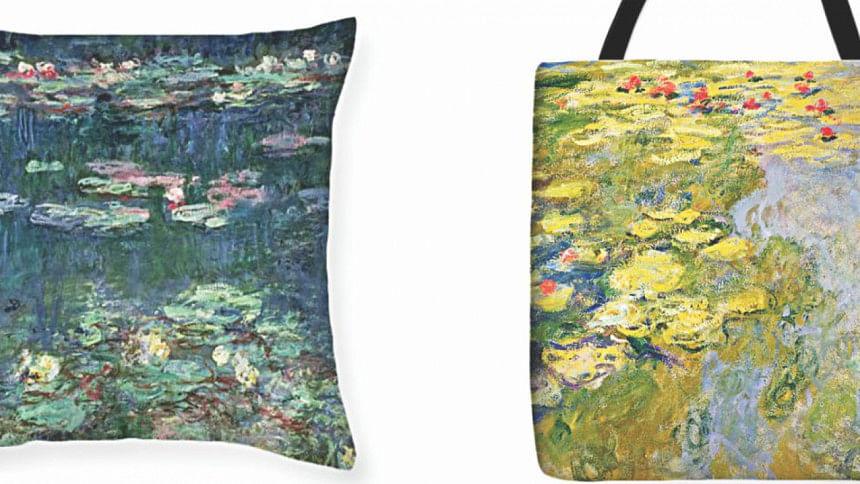
There are others who own reproductions of the 'Lilies' without having seen them in person. Here, the more pertinent effect is to convey a message about that person's taste and personality. By wearing or decorating her surroundings with prints of the 'Water Lilies', a person announces that that is her stylistic choice. She informs them that those are the colours and the style of painting she prefers, that she is familiar with Impressionist art and perhaps subscribes to the political and intellectual ideologies that come with it. Whether these messages are true is tangential; what matters is that they are projected to construct an idea, an image, an 'aura' of that person in front of the world that she meets. While this is different from the aura emanated by Monet's art, it is by witnessing such tastes and practices that many others become aware of Monet's 'Water Lilies' and Impressionist art. These different ways of finding and experiencing art beget our interaction with art in its original setting, surrounded by the "traditional" aura that Benjamin propounds.
But what is one's experience with Monet's 'Water Lilies'? How is it different from seeing their reproduced forms? "[The] unique existence of the work of art determine[s] the history to which it was subject throughout the time of its existence," explains Benjamin in his essay. This is certainly true of the 'Water Lilies'. A print of the lilies on a scarf, an umbrella, or even a framed miniature won't reveal the physical traces of its historical existence, nor the complex blend of colors and skill used by Monet on the originals. It won't help me experience Monet's grand artistic endeavour as he had intended it. The eight (out of the 300 in total) 'Water Lilies' housed by the Musée de l'Orangerie are 1.97m tall and span nearly 100 linear meters of painted landscape, according to the museum catalogue. The entire work is said to take up 200 square meters of space. In addition to the sheer size, the egg-shaped walls intensify one's feeling of being ensconced in an "endless horizon" filled with trees, willows, water lilies, and clouds. Most interestingly, these plants don't appear in the paintings as themselves, but as abstract impressions of their reflections on the pond water in Monet's garden.
Monet completely disposed of the material world in the paintings from 1905 onwards, immersing the viewer entirely in the distorted "reality" of the pond's reflections. By 1908, he was creating "unique atmospheric effects" by painting the lilies on vertical canvases and using varying colour palettes to depict the pond at different times of the day. After experiencing art of such nuance and magnitude, it's hard not to agree with Benjamin's insistence for the "presence of the original as a prerequisite to the concept of authenticity". It would certainly be difficult to discern such details of colour and perspective in smaller and scattered reproductions of the 'Water Lilies'. It would be entirely impossible to feel surrounded by the scenery on all sides at different times of the day, and be able to imagine a distorted, colourful reality without the shape and grandeur of the original paintings.
This might confirm the shortcomings of mechanically reproduced art. But reproductions of the 'Water Lilies' are so vastly, so blatantly different from the originals in the effects that they produce on the viewer that it eliminates even the scope for their comparison. To me, the reproductions seem aware of this difference, and so they settle for serving as reminders. They entice us to visit the originals. Enamoured, we try to retain their essence on regular, everyday objects.
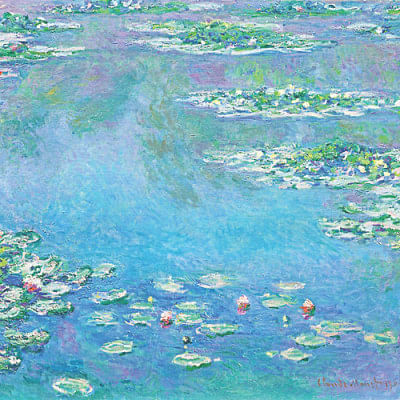
At the Gardens: The Effect of the Original
If reproductions of the 'Water Lilies' remind us of Monet's original paintings, the paintings in turn remind us of something else: the water garden painstakingly crafted by Monet in Giverny, Clos Normand in 1893. Winning against local farmers' legal objections that diverting the river Epte for the pond would poison the local water, flora, and fauna, Monet fashioned his estate after the prints of Japanese gardens that he used to collect. He built a Japanese-style bridge strung with violet wisteria and allowed the garden's asymmetrical curves and angles to grow wildly covered with bamboos, willows, Japanese peonies, maple trees, and the famed white lilies. As the website for Givernet, a not-for-profit tourism organisation in Giverny, acknowledges, Monet thus "shaped his subjects in nature before painting them, [therefore] creat[ing] his works twice". This makes the 'Water Lilies' paintings a reproduction of Monet's first work of art—his water garden.
By painting the reflections of the lilies on the pond water, Monet seems to agree with Benjamin that, "Even the most perfect reproduction of a work of art is lacking in one element: its presence in time and space, its unique existence at the place where it happens to be". While reproductions of the paintings merely hint at their failure to recreate Monet's art, his paintings more directly announce their inability to recreate the water garden. The shape and proportions of the 'Water Lilies' and the absence of the material world on their canvas aim at a grand immersive experience for the viewer, like an attempt to become a "[near] perfect reproduction of a work of art", in Benjamin's words. But by depicting the reflections of the lilies instead of the flowers themselves, the paintings confess to their "lacking", marking the extent to which they can recreate the garden. They know that transporting the viewer to the time and place of the garden is impossible; hence she must be sated with their reflections. And by projecting so many abstract perspectives of the reflections in nearly 300 installments, the paintings highlight how even a reflection of the garden produces innumerable interpretations. It makes one wonder—how much more multidimensional and overwhelming must the actual sight, the original art of the garden, be?
How overwhelming indeed. In elaborating the follies of reproduced art, Benjamin complains that, "Mechanical reproduction [...] changes the reaction of the masses toward art. [...] Individual reactions [become] predetermined by the mass audience response they are about to produce". This couldn't be truer than in 2018, when visitors of Monet's art have already been preconditioned to take an interest in them by social media and globalised cultural exchange. The mechanical reproduction of the 'Lilies' misleads our expectations because, separated from the environmental realities of a densely-grown water garden, the prints lead us to expect a solitary idyll. The variety of hues melting into a sea of blue promises a location where cool elements like water drown out noise, heat, and human crowds. This feeling is even more intense when one is surrounded by the panorama at the Musée de l'Orangerie. As a result, an actual visit to Giverny comes as a shock to the senses.
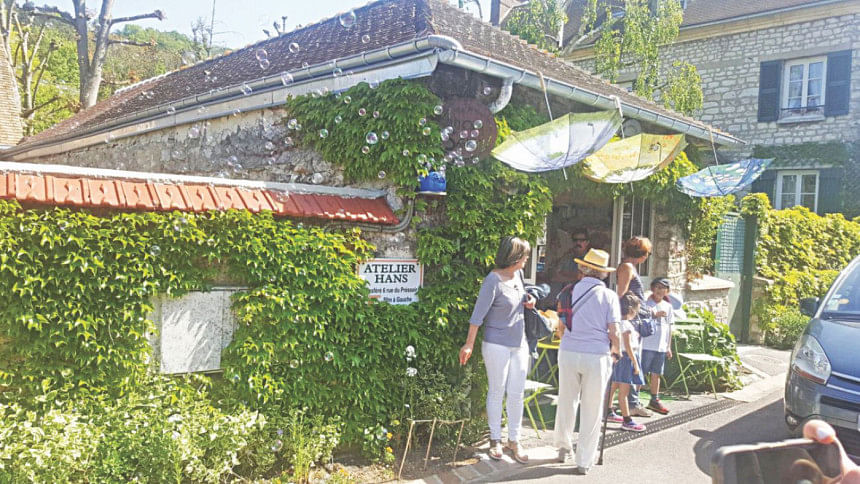
The water garden in Giverny currently functions as the Fondation de Claude Monet, an hour's ride away from Paris and open to the public from late March to early November every year. I went there in the first week of May, on a day with blazing sunlight and heat that sticks to the skin. Monet's estate was a 20-minute drive away from the Gare de Vernon train station, although finding and queuing up for a tourist bus took up another 30 minutes. Upon reaching the location, visitors have to walk through a large parking area, a small underground tunnel, and a maze of streets before reaching the entrance to the Fondation. What follows is an hour-long queue in the heat, depending on when you join the line, and more jostling through crowds and gift shops, restaurants, and art exhibitions, until you finally arrive at the gardens.
To describe it as picturesque would be an understatement. There are flowers of every colour and shape imaginable. There are butterflies, bees, dragonflies, curious green insects, croaking frogs, wildly chirruping birds. There are throngs of visitors taking pictures from every possible angle, while a few quiet ones sit in a corner sketching or painting the surroundings onto paper. The biggest surprise? The pond water was green instead of Monet's famous blue, and the lily pads were vacant of the famous lilies on the water. We snaked our way through the gardens until we started getting bitten by bugs, and made our way back through the mazes, the parking lot, and the drive back to the station. The journey back to Paris was so hot and stuffy that all the passengers cheered in relief upon stepping off the train at Gare St Lazare.
I've just made a visit to Giverny sound like a horrible experience; but that would be incorrect. It was merely different from the experience Monet's paintings lead me to expect. By depicting his water garden in nearly 300 installments on gigantic canvases washed in blue, Monet led us to imagine the place as a quiet, peaceful dreamworld where white lilies are eternally in bloom. Instead, I found myself in an intense vacuum of noise, colours, and different life forms, with no lilies in sight. I realised that looking at Monet's reproduction of the garden, and the countless reproductions of Monet's paintings, had made me forget about the realities of time and place—about whether the lilies would have grown by that time of the year, and whether I would find other life forms amidst such densely-grown flora. The experience seemed to corroborate perfectly with Benjamin's opinions on what reproduced art does to our expectations from the original.
But it's precisely this sensory shock that left a strong impact on me.
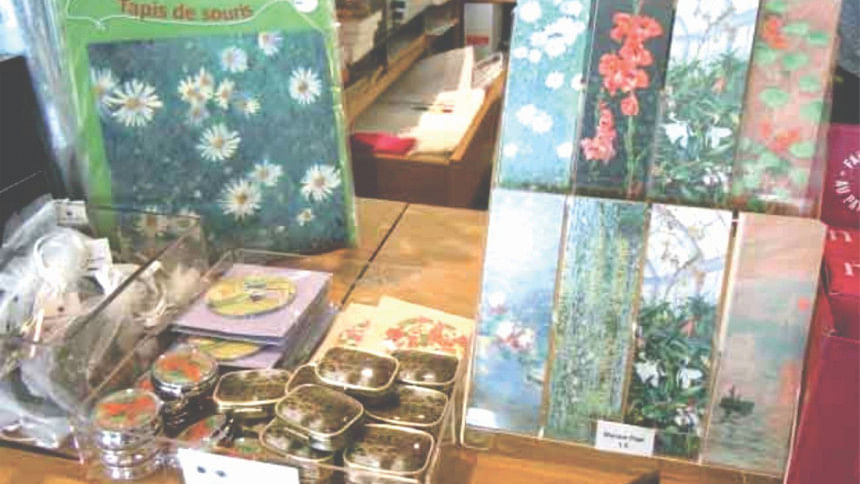
Finding a world identical to the many reproductions I'd already encountered would have made my visit to Giverny inconsequential and forgettable. The contrast between my expectations and reality, the presence of elements absent from the paintings, and the absence of a crucial element of the paintings, fuel the memory of the time and place— the 'unique' aura—of Monet's water garden for me. Benjamin may have been correct that reproduced art changes the audience's response to it, but it is the tension between these changes that makes for an interesting experience with art and helps us truly remember it.
If art, according to Benjamin, is meant to be experienced in its original setting, then reproduction of art enriches that experience through the powers of memory and contrast. It informs the masses about the existence of art, reminds them to partake in its experience, and helps them announce their admiration of that experience by owning it in reproduced forms. This mythologisation creates unfeasible expectations, but it is by travelling from misperception to disillusionment that the audience can truly decide on its sentiments toward art. Experiencing Monet's 'Water Lilies' in their different forms of reproduction provides a fitting example. The journey of the 'Lilies' from Monet's garden to his canvas to today's souvenirs reveals the nuances in the relationship between art and its original setting. It reminds us that the subject of a painting is never born afresh on the canvas. As a result, the 'aura' of its origin becomes too elusive, too endurant to be destroyed by mechanically reproduced art.
Sarah Anjum Bari completed her Master's degree in History and Literature at the Columbia University centre in Paris. Her writing has appeared on Electric Literature, The Daily Star Bangladesh, The Financial Express - Bangladesh, Disconnect - Collected Short Fiction, and the Bangladesh PEN Journal 2015.

 For all latest news, follow The Daily Star's Google News channel.
For all latest news, follow The Daily Star's Google News channel. 



Comments